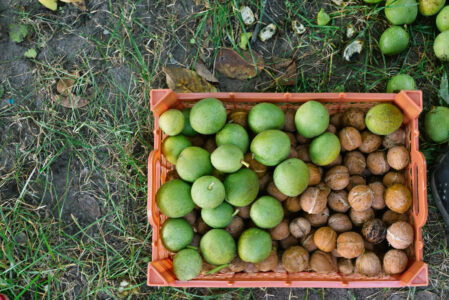Famously tough, you can easily learn how to crack black walnuts. Start husking black walnuts with your family today all throughout the season.
Crouched behind a tree as walnuts whizzed through the air, their fleshy green husks exploding on impact, my 11-year-old self quickly gathered up a dozen or so. With the sound of friends’ laughter drawing closer, I knew it was now or never. I stepped out from behind the tree, walnuts at the ready, and hurled the artillery in quick succession. I fired off three quick blasts, each of them landing true, then followed up with an immediate second round, and a third, until I had but one walnut left and raised at the ready.
The “enemy” surrendered, and I won the day. We all walked home from the park that evening, laughing and slugging shoulders. Though we were bruised and beaten, we wouldn’t have had it any other way.
These days, for safety’s sake, I discourage using black walnuts as projectiles. However, I certainly recommend gathering them for food. Considered a “superfood,” black walnuts are high in omega-3s and antioxidants. Plus, they pair exceedingly well with dark chocolate (or any chocolate, really).
Black walnut trees are very common and produce in enormous quantities, and you may have one right in your backyard, as I do. Black walnuts are like gifts from the heavens: food and medicine that falls from the sky. In a bygone era, they might have been celebrated for these attributes, but today they’re despised for denting parked cars and ruining mower blades. Don’t be discouraged by their bad reputation. With a little know-how, you can crack the black walnut code and get a delicious, nutritious food that’s definitely worth the effort.
The Mighty Walnut Tree
Eastern black walnut trees (Juglans nigra) have extremely straight trunks that can grow up to 150 feet tall and 8 feet in diameter, though more often you’ll see adult specimens in the 50-to-75-foot range, with diameters of 2 to 3 feet. Large and impressive, the trees reach maturity in 150 years.

The leaves of black walnut trees are compound, meaning they have two rows of leaflets on opposite sides of a vein. A leaflet is commonly thought of as a leaf, but the leaf is actually comprised of a group of 12 to 20 or so small leaflets.
As their name implies, Eastern black walnuts are native throughout most of the eastern United States, and here in Indiana (Zone 6) the nuts ripen from late summer through most of autumn. This lengthy period can be somewhat attributed to environmental factors, but is mostly due to the fact that ornamentally planted trees represent many different cultivars from around the country. I have one tree on my property from which I can start gathering nuts in early September, but there are parks nearby with trees dropping nuts from August through October. I can typically find viable nuts on the ground through November.
How to Husk
Biologically speaking, the black walnut is not a true nut, but rather a drupe. Think of it like a peach, with the walnut itself as the pit. In the case of black walnuts, the pit is what we’re after, if we can just get to it under the pesky husk.

Removing the husks can be done a number of ways. Many people prefer to break them off immediately, while the husks are still fresh — and with good reason. When the husks rot, they become a goopy mess of deep-black ink that looks like crude oil and stains everything it touches, even concrete. It can even soak into the shell of the walnut and taint the nutmeat inside, which will ruin it if enough soaks through.
A popular husk removal method is to drive over the nuts with a car. This method works, but is cumbersome and time-consuming at best. The real key to making easy work of husking walnuts is to catch them at just the right stage of ripeness — when they’ve been on the ground long enough for the husks to soften, but not long enough for them to rot. At this stage, they’ll still be green, but will have prominent yellow and black splotches, and many of them may be starting to break open slightly. When they get to this stage, stomp them with your feet right where they lay on the ground, and you’ll break off much of the husk. If the ground is soft, just pick them up, tap them against the tree trunk, and rub the husk off. Even at this stage they’ll stain your hands, so wear gloves if you’re not interested in wearing the “walnut badge of courage” for the next week.
Another method of removal is to let the walnuts dry until the husks turn brittle and simply fall away when crumbled in your hands. The previously mentioned black sludge is inevitable to some degree with this process, so you need to make sure the nuts are located where the mess won’t be a problem. I typically stack two old milk crates on top of each other in my garage, lining the bottom one with plastic bags and the top one with a single layer of unhusked nuts. A bit of black sludge drips into the plastic bags below, and dried nuts with easily crumbled husks remain above. This method saves a little effort when it comes to breaking the husks off, but since you can only go one layer deep or risk the nuts becoming tainted by the rotting husks, it takes up a lot of space if you’re drying more than a few.

Once you get the husks removed, you can soak them in water to make clothing dye or hide-tanning solution. This concoction also makes a decent weed killer, but do your research before applying it to your garden or adding the husks to your compost pile; walnut husks, leaves, and wood contain a chemical called “juglone” that’s toxic to many garden plants.
A Tough Nut to Crack
After the husks are off, you need to get through the hard inner shell, and this thing is no slouch. To give some perspective, black walnut shells are used industrially for sandblasting. They’re really, really hard. A tough shell is one of the black walnut’s defense mechanisms, and it’s a good one. Don’t be discouraged, though; black walnuts are a little labor intensive, but they’re worth the effort and ingenuity it takes to get to the prize.
A common method for penetrating the walnut shells is to bash them with a hammer. This can work quite well, or it can destroy them, depending on your technique. For the best chance at success, use your non-dominant hand to steady the nut on a concrete surface with the flatter side up. Hit it, but don’t pulverize it. Sandwich the nut between towels to help minimize the mess and keep it from being pulverized. This method breaks well-dried walnuts into pieces so the nutmeats can be extracted easily with a nutpick, but I’ve found that it tends to cause more damage to the nutmeats than I’m willing to accept.
Recently I discovered a better way to get a successful shelling. I took my kids to the playground at the same local park where my classmates and I used to play. There are several big trees there that drop tons of nuts every year. A gentleman was sitting on a park bench with a mound of walnuts at his feet and a nice pile of shelled, ready-to-eat nutmeats on the bench next to him. He would take a nut from the pile, set it on the concrete at his feet, and give it a few moderate taps with a brick. The nut would come apart in reasonably uniform pieces, and he seemed to be getting nice, big pieces of nutmeat out with just his fingers. I had never seen anyone make such quick work of shelling black walnuts.

This method really works and has become my go-to. It’s so effective that I doubt I’ll ever buy a commercial nutcracker. I still need to use a nutpick to get some bits of the nutmeat out, but using the brick instead of the hammer results in fewer damaged nutmeats, larger pieces, and much faster results. The weight distribution of the brick seems to break down the integrity of the shell, like strategically placed dynamite breaks down the integrity of a building during demolition. One or two good taps with the brick, and that mighty fortress of a shell simply falls away.
You’ll get bigger pieces using a brick than with a hammer, but you’ll still get very few uniform halves, like you may be used to with commercially available English walnuts. If you’re dead set on extracting very large and uniform nutmeats, you can use a vise to add slow pressure until the shell cracks. While this does work, it’s an incredibly slow and arduous process.
Commercial black walnut crackers are available on the market, but most of them don’t work very well, and the ones that do are pricey. One heavy-duty manual cracker I saw handled one nut at a time and cost $150. The thing would just about break your elbow if you did five or six nuts in a row. But what if you have five or six dozen, or five or six hundred? Machine crackers range from about $500 to $5,000 or more; that’s quite an investment for noncommercial production, and produces some really expensive pancake topping.
Worth the Work
Dry nuts in their shells will remain viable indefinitely, but they’re at their prime when stored in a cool, dry place for no more than a year or so. Dry, shelled nuts will store in the pantry quite well for about the same amount of time in a sealed container. As with most nuts and seeds, the key is to keep them good and dry, or they’ll spoil. If they’re moist when you shell them, you can air dry them somewhere with good airflow, such as a kitchen counter, or finish them off in a food dehydrator on the low setting.

Though the shape and appearance of black walnuts are similar to the more ubiquitous English walnut, the flavor is bolder and more distinct. I think black walnuts excel in recipes that normally call for English walnuts, adding a strong quality that’s almost liqueur-like. They’re great in cookies, fruit breads, and other baked goods, and they turn plain vanilla ice cream into a gourmet dessert.
Black walnuts are delicious, nutritious, and, best of all, usually free for the taking! Get out there and get some before they go to waste.
More from American Heirlooms:
• Black Walnut Banana Bread Recipe
Clyde Myers is a journalist and blogger who teaches workshops on foraging wild food plants, acorn processing, and other topics in southern Indiana, where he lives with his wife and two daughters.







